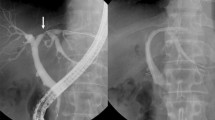Abstract
We describe a technique to bypass a malignant biliary obstruction by creating a direct connection between the left biliary tree and the stomach. First, adherence between the left liver parenchyma and the stomach is achieved by a Cope anchor system. Then, the left biliary tree and stomach are connected by Colapinto needle puncture of the stomach from a left biliary duct with the needle inserted through a 9 Fr transhepatic sheath. Over a stiff guidewire, a Ring drainage catheter is placed. Later, the Ring catheter is replaced by a metallic stent. Four patients with malignant biliary obstruction underwent this procedure. The mean survival time was 77 days with maximum follow-up of 171 days. Neither obstruction nor dislocation of the metallic stents occurred.
Similar content being viewed by others
References
Ott DJ, Gilliam JH, Zagoria RJ, Young GP (1992) Interventional endoscopy of the biliary and pancreatic ducts: Current indications and methods. AJR 158:243–250
Lai EC, Chu KM, Lo CY, Fan ST, Lo CM, Wong J (1992) Choice of palliation for malignant hilar biliary obstruction. Am J Surg 163:208–212
Ferrucci JT Jr, Mueller PR, Harbin WP (1980) Percutaneous transhepatic biliary drainage. Radiology 135:1–13
McLean GK, Burke DR (1989) Role of endoprosthesis in the management of malignant biliary obstruction. Radiology 170(3):961–967
Coons HG (1989) Self-expanding stainless steel biliary stents. Radiology 170:979–983
Mueller PR, Ferrucci JT Jr, Teplick SK, Van Sonnenberg E, Haskin PH, Butch RS, Papanicolaou N (1985) Biliary stent endoprosthesis: Analysis of complications in 113 patients. Radiology 156:637–639
Adam A, Chetty N, Roddie M, Yeung E, Benjamin IS (1991) Self-expandable stainless steel endoprosthesis for treatment of malignant bile duct obstruction. AJR 156:321–325
Dick BW, Gordon RL, Laberge JM, Doherty MM, Ring EJ (1990) Percutaneous transhepatic placement of biliary endoprosthesis: Results in 100 consecutive patients. J Vasc Intervent Radiol 1:97–101
Rossi P, Maccioni F, Ricci P, Bezzi M, Salvatori FM, Santoro P, Gandini R (1991) Interventional radiological approach for palliation of malignant biliary obstructions. Curr Top Surg Oncol 184:277–290
Passariello R, Pavone P, Rossi P, Simonetti G, Modini C, Lasagni PR, Mannella P, Gazzanica GM, Paolini RM, Iaccarino V, Feltrin GP, Roversi R, Mallarini G (1985) Percutaneous biliary drainage in neoplastic jaundice. Acta Biol Diagn 26:681–688
Günther RW, Schild H, Thelen M (1988) Percutaneous transhepatic biliary drainage: Experience with 311 procedures. Cardiovasc Intervent Radiol 11:65–69
Tipaldi L, Santoro E, Squillaci S (1993) The hepatogastric drainage: A new percutaneous bilioenteric anastomosis, (abstract) Cardiovasc Intervent Radiol 16(suppl):S50
Soulez G, Gagner M, Therasse E, Deslanders E, Pomp A, Leduc R, Bernard EJ, Prosmanne O, Robillard P (1994) Malignant biliary obstruction: Preliminary results of palliative treatment with hepaticogastrostomy under fluoroscopic, endoscopic and laparoscopic guidance. Radiology 192:241–246
Author information
Authors and Affiliations
Rights and permissions
About this article
Cite this article
Tipaldi, L. A simplified percutaneous hepatogastric drainage technique for malignant biliary obstruction. Cardiovasc Intervent Radiol 18, 333–336 (1995). https://doi.org/10.1007/BF00203688
Issue Date:
DOI: https://doi.org/10.1007/BF00203688




